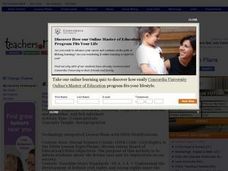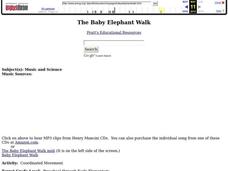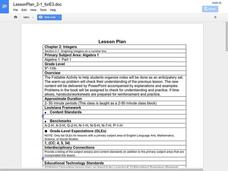Curated OER
Brown v. Board
Pupils investigate Brown versus Board of Education. They read and discuss a handout, discuss vocabulary terms, and in small groups create a brochure, bookmark, puzzle, and a short skit.
Curated OER
Text as Texture Collage
Students explore the concepts of rhythm, movement, contrast and texture. They practice using new vocabulary and work on creating a college after designing the arrangement. They self-evaluate their collage and critique their classmates...
Curated OER
World War II
Students analyze primary sources (photographs) for evidence of American military technology during WWII. They debate the use of the Atomic Bomb. Students view the Rosenthal image. They discuss the image in detail.
Curated OER
Keeping Our Pets Safe In An Emergency
Students fill out worksheets that teach them how to prepare for emergency situations and how to enable animal safety in emergency situations. In this emergency lesson plan, students talk about different kinds of emergencies and how they...
Curated OER
The Baby Elephant Walk
Students use the song Baby Elephant Walk to practice following a steady beat. In this coordinated movement lesson, students discuss baby elephants and their movements. Students listen to the song 'Baby Elephant Walk' and follow the...
Curated OER
Encounters – Native Americans and Euro Americans (1850-1870)
Students consider the plight of Native Americans. In this Oregon history lesson, students research Internet and print sources regarding land conflicts between the whites and Native Americans. Students discuss resettlement and...
Curated OER
Integers
Students graph integers on a number line. In this integers lesson, students create a colored foldable to assist them with notetaking and problem solving. Students complete exercises from text.
Curated OER
Robot Area
Learners calculate the area of different polygons. In this geometry lesson, students explore polygons based in their shape and number of sides. They find the formula for the area and use each specific formula for each shape.
Curated OER
Different! Diverse! Dynamic! Lesson 1: Late Bloomers
Students examine how people grow and mature at different rates. They create a graph and a timeline to organize the data they collect.
Curated OER
Words Can Hurt: King Day
Students explore stereotyping. In this moral and character development lesson plan, students share reactions to a T-chart displaying what boys can do and girls can not do. Martin Luther King's accomplishments are discussed, and...
Curated OER
The Rewards of Caring
Pupils explore the concept of democracy. In this character education lesson plan, students discover enlightened self-interest and discuss a quote from Alexis de Tocqueville.
Curated OER
Who Works for Nonprofits?
Students explore career opportunities in the nonprofit sector. In this character development and career instructional activity, students identify job opportunities in a nonprofit organization and research the necessary skills needed for...











